Thank you, MaryAnn, and good afternoon to everyone.
My name is Jeff Anderson. I am the chair of the Fort Vermilion Seniors' and Elders' Lodge Board 1788. With me on the telephone is Chief Rupert Meneen, chief of Tallcree First Nation, a critical partner of our board, and sitting before you is our treasurer, Mr. Bill Boese; and Natalie Gibson, our researcher and adviser.
It is absolutely an honour to address the Standing Committee on Indigenous and Northern Affairs on the important topic of seniors and elders care.
For over 10 years, the community of Fort Vermilion has actively advocated for a designated seniors live-in care facility in the Fort Vermilion area. We wish to advise of the long-term, unmet need for seniors and elders care beds in the Mackenzie region of Alberta, especially when considering the needs of one of Canada's fastest-growing demographics, the indigenous population.
Our board and first nation partners are requesting that the Government of Canada work with the provinces to meet the needs of those in rural, remote, northern areas that are under-serviced. This includes more than just long-term care. It includes support services that affect one's quality of life.
We have all of the studies showing the need, yet nothing has occurred to date.
In 2014, the Alberta government partnered with Mackenzie County to conduct a regional housing needs assessment study. This $100,000 study determined that there was an existing and projected need for an additional 117 to 200 care beds for seniors between the dates of 2014 and 2031 in our region. It was recommended that eight to 13 assisted-living beds were needed in Fort Vermilion immediately, in 2014, four years ago, and an additional 14 to 24 beds by 2031. In 2031, the population of those who will be 65 years and over is expected to increase 123.8%, to an estimated 2,417 persons.
Since 2014, the inventory of 122 designated care beds in the Mackenzie region has changed only slightly, with the addition of four care beds in 2017. Currently, all designated supportive living facilities in the region are 100% full, and the DSL waiting list is up to two years. In addition, the facilities do not recognize the unique cultural diversity of the region. Seniors are forced to stay home longer, or they have to go out of the region for supportive care. As our people are staying in their homes longer, we encounter other challenges.
We also have a shortage of health care practitioners. We have reports of local nurses not having been able to take holidays in the last two years.
In rural and remote regions, health care services are much more difficult to access. Seniors close to urban centres can hail a cab to go to buy groceries, or a handi-bus to reach a doctor to refill a prescription. In our remote communities in northern Alberta at times, seniors can't even call 911 in an emergency due to a lack of cellular service.
As a group of passionate volunteers, we have formalized the Fort Vermilion and Area Seniors' and Elders' Lodge Board 1788. In your briefing notes, I invite you to see 10 bullet points outlining our progress.
In summary of those bullet points, the board of 13 includes four appointed directors, one from each of the Dene Tha' First Nation, Tallcree tribal government, Beaver First Nation, and Little Red River Cree Nation. Along with our partners, we have fundraised over $200,000 through a community thrift store and donations. We have had land donated, and we have access to two other pieces of land that we can access to build a facility.
We are working hard to build awareness that the standard formulas used for assessment and tracking of health care needs and supportive services do not work well in northern remote communities. We are now part of a large cross-ministry strategic task force with provincial and federal departments, to discuss the gaps in information and service provision. To date, the task force has met three times on three separate calls, with no outcomes yet.
To give a little understanding of our area, in your briefing notes there, we're part of what's called the Mackenzie County. It is the largest geographic county in Canada, about the size of Prince Edward Island. On page two of your briefing notes, you can see the eastern reserve of Garden River. It is approximately two and a half hours to travel to the St. Theresa General Hospital located in Fort Vermilion.
From Fox Lake, just a little south of it there on your map, via a barge, it's three to four hours to get to Fort Vermilion. High Level, which is towards the left of that little map and in the centre, has a hospital and a proposed lodge with a 25 DSL room project under way. Even with that new facility our needs are far from being met.



